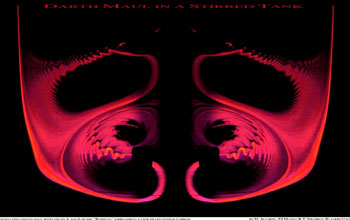Multimedia Gallery
Darth Maul in a Stirred Tank
Darth Maul in a Stirred Tank
This figure shows an experiment in which fluorescent dye is injected near the center of a stirred tank of glycerine and the tank is illuminated from the side by a vertical laser sheet. The tank is stirred at Reynolds number 30 by two sets of impellers, visible as superimposed gray squares: one beneath the 'nostrils' of the pattern, and one above its 'eyes.' The oscillatory lobes of dye emanating from the impeller blades are hallmarks of a chaotic mixing process. The vanes of the upper impeller are uniformly spaced, producing simply periodic lobes, while the vanes of the lower impeller are unevenly spaced, producing repeated 'm'-shaped lobes. This figure provides graphic evidence that it is the 3-Dimensional enfolding of fluid around the impeller vanes that leads to chaos and mixing in this common industrial mixer. Indeed, careful accounting of the energy expenditure in this system reveals that 90 percent of the kinetic energy present is associated with large-scale recirculating, nonmixing, flows (evident here as the open, black, island structures), and only 10 percent of the kinetic energy generates measurable mixing.
[Image processing notes: In this figure, the illuminating laser sheet was placed exactly in the center of the tank, and so one half of the tank was in the shadow of the central vertical impeller shaft. To produce this figure, we duplicated and inverted the right half of the original image and placed it in position on the left. The dye used is rhodamine dissolved in glycerine to neutral buoyancy; the color shown here is digitally enhanced.]
More about this Image
This work was performed at the Center for Structured Organic Composites (C-SOC), a National Science Foundation Engineering Research Center (ERC) based at Rutgers University. The center was established to study the nature of finely ground granular materials and other substances that form the core of drug tablets, processed foods, agricultural chemicals and other "composite organic" products. In addition to improving the quality and consistency of such materials, the center will develop more consistent and cost-effective manufacturing techniques than methods based largely on trial and error.
To learn more about work at this center, visit the C-SOC Web site. Further information about the NSF Engineering Research Centers program, including a list of the centers currently funded and links to their Web sites, is available at http://www.nsf.gov/funding/pgm_summ.jsp?pims_id=5502. (Date of Image: unknown) [One of several related images. See Next Image.]
Credit: M.M. Alvarez-Hernandez, F.J. Muzzio, Troy Shinbrot; ERC for Structured Organic Composites for Pharmaceutical, Nutraceutical and Agrochemical Applications
Images and other media in the National Science Foundation Multimedia Gallery are available for use in print and electronic material by NSF employees, members of the media, university staff, teachers and the general public. All media in the gallery are intended for personal, educational and nonprofit/non-commercial use only.
Images credited to the National Science Foundation, a federal agency, are in the public domain. The images were created by employees of the United States Government as part of their official duties or prepared by contractors as "works for hire" for NSF. You may freely use NSF-credited images and, at your discretion, credit NSF with a "Courtesy: National Science Foundation" notation.
Additional information about general usage can be found in Conditions.
Also Available:
Download the high-resolution JPG version of the image. (896 KB)
Use your mouse to right-click (Mac users may need to Ctrl-click) the link above and choose the option that will save the file or target to your computer.



